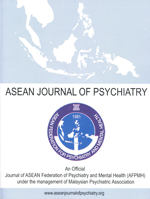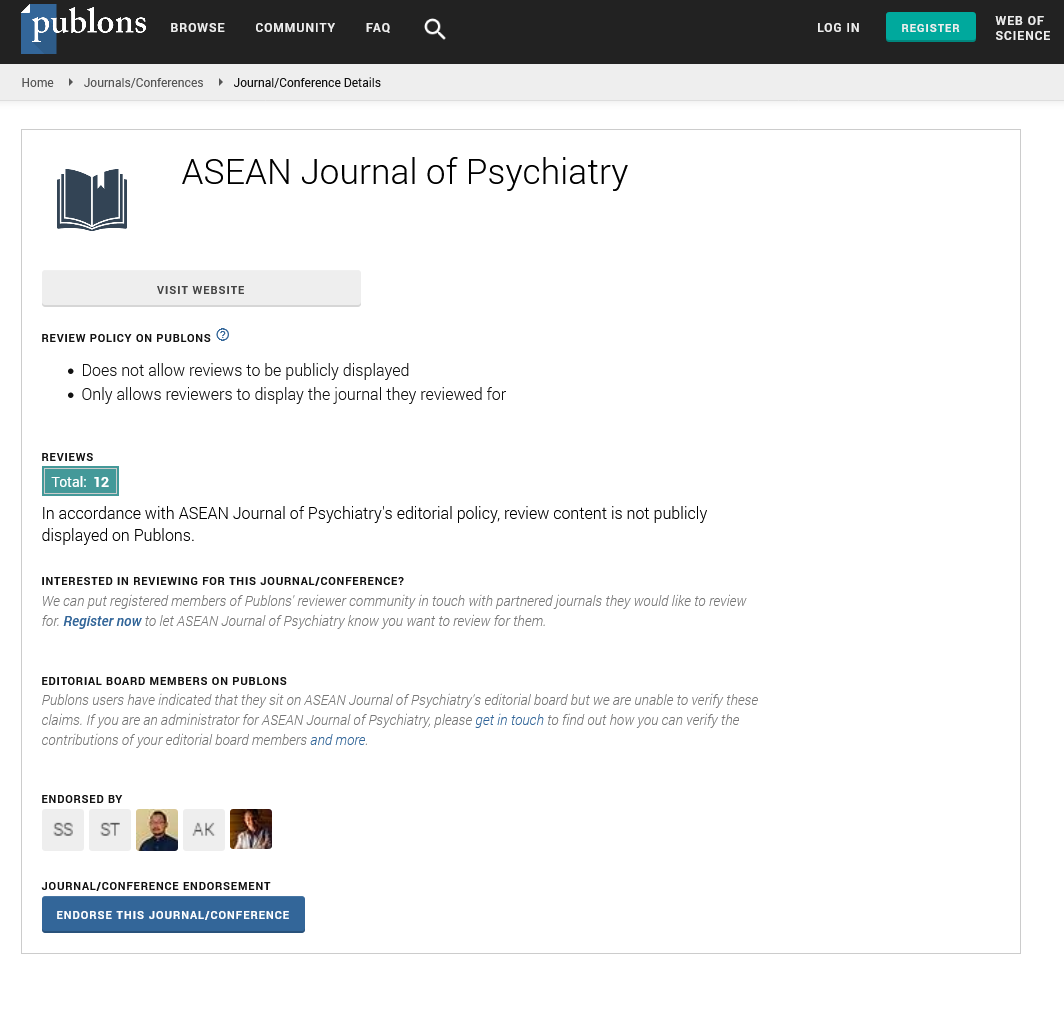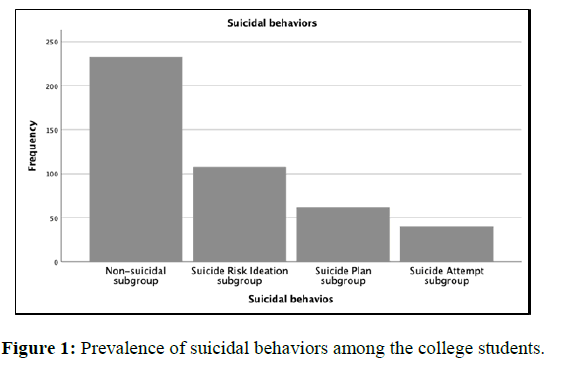Introduction
South Suicide is a serious public health concern
worldwide, ranking as the fourth leading cause
of death among 15-29 year old and the third
among girls 15-19 years old [1]. WHO reported
that there would be an estimated 804,000 suicide
deaths worldwide in 2021. The World Health
Organization defined suicidal behavior as a
range of behaviors that include thinking about
suicide or ideation, planning for suicide,
attempting suicide, and suicide itself. Suicidal
behavior can be considered to consist of ideation, attempt, and suicide. Suicide is the act of
deliberately killing oneself [2]. In the
Philippines, around 3.2 deaths relating to suicide
were recorded per 10,000 inhabitants in 2011 [3].
The Philippine Statistical Authority (PSA)
recorded 3,529 death cases due to intentional
self-harm in 2020. Usually, those who commit
suicide tend to be older, male, use more lethal
methods, and die on the first attempt [4].
Moreover, official suicide rates are lower in the
Philippines as compared with many other
countries. Very likely that suicide cases were
underreported due to cultural differences such as religious beliefs, stigma to the families, and lack
of understanding on suicide.
The Philippines today according to the United
Nations Population Fund has the largest
generation of young people in our history. Thirty
(30) million young people between ages of 10 to
24 account for 28 percent of Philippine
population and about 19.8 million are adolescent.
Said organization clearly emphasized that
developing policies and investments for the
future of these young people could lead the
Philippines to reap the benefits of a demographic
dividend-the economic growth potential that can
result from shifts in a population’s age structure,
mainly when the share of the working-age
population is larger than the non-working-age
share of the population or the dependent
population. Yet, these young people are also
facing different challenges and even lifethreatening
risks such as suicidal behaviour. The
study conducted by Refaniel, et al. through data
review for suicide deaths between 1974 and 2005
obtained from Philippines Health Statistics
reported that suicide rates were highest in 15-24
year-old in females and surprising suicide rates
were increasing every year. Further, the
identified most commonly used method for
suicide was hanging, shooting, and
organophosphate ingestion [5].
Suicide has a devastating and long-lasting impact
on families, friends, and communities; however,
suicide has no known definite cause [6]. There is
no single factor that would explain why the
individuals take their own life or why they hurt
themselves. Suicidal behavior is a complex
phenomenon influenced by several interacting
factors such as personal, social, psychological,
cultural, biological, and environmental [2].
Previous studies have reported several risk
factors associated with suicidal behavior among
young people. Psychological risk factors related
to suicidal behavior were depressive moods,
substance use, and history of severe
psychopathology [7-12]. Moreover, with regards
to personal, social, and environmental factors,
suicide behavior was found to be associated with
unemployment, low educational attainment, not
studying, and low achievement family problems, bullying victimization, no or few friends, food
insecurity, female sex, LGBTQ+ gender
orientation, sleep problems, and obesity [13-16].
Existing literature showed suicidal behavior was
negatively associated with religious affiliation;
social support, parent-family connectedness, and
positive affect [11,17-21]. However, very little
research has focused on protective factors
because most studies highlighted the negative or
the risk factors [22-24].
This study aimed to investigate the prevalence of
suicidal behavior among college students in a
state university in Pampanga and examined the
risk and protective factors most associated with
suicidal behavior. This current study is essential
to provide a picture of the size of the problem
and facilitate better-informed decisions, and
formulate potential etiologies and preventive
actions in the state university [5,25,26].
Materials and Methods
Research design
A cross-sectional survey was utilized to
determine the prevalence of suicidal behaviors
and examined the association of risk and
protective factors among college students in state
university in Pampanga.
Study population and sample
Pampanga is located on the northwest of Manila.
It has an estimate of 2.5 M population and the
age group with the highest population in this
province is 15 to 19 years old. The survey was
conducted on college students in a state
university in Pampanga during the academic year
of 2021-2022. A minimum of 385 college
students is required to achieve a 95% level of
confidence, precision of 5% given an estimated
prevalence of suicidal behaviors of 50%. All
colleges were included in the sample range using
a cluster sampling. A total of 443 students were
voluntarily participated in the study.
Data collection procedure
An online survey was created using Jotform
(https://www.jotform.com). Information about the study was placed at the beginning of the
survey and was followed with an online
informed consent form. Only participants who
voluntarily agree to participate in the study were
included in the survey. The online survey
included questions on demographic
characteristics of the participants such as age,
gender, year level, academic status, and the
seven (7) self-report standardized questionnaires.
The online survey’s duration was approximately
20-25 minutes. The link to the study was
distributed through the student leader per class.
The link remained active for one month during
the month of June 2022. The study complied
with the ethical guidelines of the state university.
Instruments
Suicidal behaviour: The Suicide Behaviors
Questionnaire-Revised (SBQ-R) developed
Osman et al. was used to assess the suicidal
behaviors of the participants. The scale consists
of 4-itmes, each item tapping a different
dimension of suicidality such as suicide ideation,
plan, and attempt. SBQ-R is a useful measure of
suicidal behavior based on empirical studies.
Symptoms of depression: Patient Health
Questionnaire (PHQ-9) is a nine-item scale
assessing the presence of depressive symptoms
over the past two weeks.
Childhood trauma history: The Adverse
Childhood Experiences (ACEs) Questionnaire is
a 10-item measure used to measure childhood
trauma. The questionnaire assesses 10 types of
childhood trauma measured in the ACE Study.
Personal: Physical abuse, verbal abuse, sexual
abuse, physical neglect, and emotional neglect.
This scale has good internal validity (Cronbach’s
Alpha=0.854) and predictive validity (R2=0.12,
p0.001 of the SHI total score). The items are
rated on a 4-point Likert scale, except for seven
items. Higher scores indicate greater exposure to
childhood maltreatment.
Gender identity: Gender identity was
determined by single question, “What is your
current gender identity?”
Family and social connectedness: The
Multidimensional Scale of Perceived Social
Support is a 12-item measure of perceived
adequacy of social support from three sources:
Family, friends, and significant other; using a 5-
point Likert scale (0=strongly disagree,
5=strongly agree). MSPSS has been widely used
in both clinical and non-clinical samples and
easily administered using a five-point Likert-type
scale. The internal consistency of the scale was
good, with a Cronbach’s alpha of 0.91 with
students.
Positive affect: The Positive and Negative
Affect Scale (PNAS) is one of the most widely
used scales to measure mood or emotion. This
brief scale is comprised of 20 items, with 10
items measuring positive affect (e.g., excited,
inspired) and 10 items measuring negative affect
(e.g., upset, afraid).
Spirituality: The Spiritual Well Being Scale
(SWBS) is a 20 item scale that measures an
individual's well-being and overall life
satisfaction on two dimensions: (1) religious
well-being, and (2) existential well-being. Items
related to religious well-being contain the word
"God" and measure the degree to which one
perceives and reports the well-being of his or her
spiritual life in relation to God. Items related to
existential well-being contain general statements
that ask about life direction and satisfaction and
measure the degree to which one perceives and
reports how well he or she is adjusted to self,
community, and surroundings.
Data analysis
The data were analysed using the Statistical
Package for Social Science (SPSS v.26, IBM
Corp, 2019). Frequency and percentage were
used to describe the characteristics of the
respondents. Multiple logistic regressions were
performed to assess how well the risk and
protective factors predict or explain the college
students’ suicidal behavior. It also allows to test
models to predict categorical outcomes withs
two or more categories (non-suicide, suicide
ideation, plan, and attempt). And the predictor
variables can be either categorical (gender, with
history and no history of adverse childhood experience) or continuous (depressive symptoms,
support from significant others, support from
family, support from friends, positive affect,
negative affect, spiritual well-being, and age).
Results
Table 1 shows the study’s descriptive results. A
total of 443 college students voluntarily
participated in the study. Majority of the
participants were female (65%) and third year
college students (41.5%).
| Variables |
Non-suicidal (n=233) |
Suicide Risk Ideation (n=108) |
Suicide Plan (n=62) |
Suicide Attempt (n=40) |
| Gender |
Male |
91 (39.1%) |
22 (20.4%) |
14 (22.6%) |
11 (27.5%) |
| Female |
135 (57.9%) |
82 (75%) |
44 (71%) |
27 (67.5%) |
| LGBTQ+ |
7 (3%) |
4 (3.7%) |
4 (6.5%) |
2 (5%) |
| Year Level |
First |
36 (15.5%) |
30 (27.8%) |
10 (16.1%) |
10 (25%) |
| Second |
15 (11.6%) |
15 (13.9%) |
12 (19.4%) |
8 (20%) |
| Third |
101 (43.3%) |
42 (38.9%) |
25 (40.3%) |
16 (40%) |
| Fourth |
68 (29.2%) |
21 (19.4%) |
15 (24.2%) |
6 (15%) |
| Fifth |
1 (0.4%) |
0 |
0 |
0 |
Table 1: Demographic profile of the participants.
According to Figure 1, most of the participants
do not engage in suicidal behavior, 52.60% 28.5)
of the participants reported suicidal ideation and
14% (95%, CI 11.07, 17.54) indicated they had
suicidal plans (Figure 1). Moreover, 9% (95%,
CI 6.7, 12.06) of the college students confessed
that they would attempt to commit suicide.
Majority of these students who reported with
suicidal behaviors were female and third year
college students. Multinomial Regression
Analysis was performed to assess the impact of a
number of protective and risk factors on the
likelihood that respondents would report that
they had any suicidal behavior. Preliminary
analyses were conducted to ensure no violation
of the assumptions of normality, linearity,
multicollinearity and homoscedasticity. The
model contained ten independent variables
(depressive symptoms, adverse childhood
experience, support from significant others,
support from family, support from friends,
positive affect, negative affect, spiritual wellbeing,
age, and gender). The whole model
containing all predictors was statistically
significant, x2 (33, N=443) = 279.115, p<0.001,
indicating that the model could distinguish
between respondents who have suicidal behaviors and those who are not suicidal. The
model explained 46.8% (Cox and Snell R
square) and 51.8% (Nagelkerke R square) of the
variance in types of suicidal behaviors
committed by college students.
As shown in Table 2, only four independent
variables made a unique statistically significant
contribution to the model (depressive symptoms,
adverse childhood, support from family, spiritual
well-being). The strongest predictor of not
committing suicide was having family support,
recording an odds ratio of 2.55. The results
indicated that respondents who had good social
support from their families were over 2.55 times
more likely to prevent themselves from
attempting to commit suicide. The odds ratio of
1.040 for spiritual well-being is also shown in
the table, indicating that students with good
spiritual well-being would likely not attempt
suicide. On the contrary, the odds ratio of .83 for
depressive symptoms and the odds ratio of .42
for adverse childhood experiences were less than
1, indicating that for every one-point increase in
the scores of symptoms of depression and adverse childhood experiences were .83 and .42
times more likely to have a suicide attempt.
| Reference: Suicide attempt |
Non-suicidal OR (Std. Err) |
Suicide risk ideation OR (Std. Err) |
Suicide plan OR (Std. Err) |
| Depressive symptoms |
0.83 (0.0)*** |
0.91 (0.05) |
0.96 (0.05) |
| Adverse childhood experiences |
0.42 (0.17)*** |
0.79 (0.13) |
0.93 (0.14) |
| Support from significant other |
0.70 (0.23) |
0.75 (0.21) |
0.80 (0.22) |
| Support from family |
2.55 (0.29)*** |
1.84 (0.26)* |
0.88 (0.27) |
| Support from friends |
0.93 (0.27) |
0.90 (0.24) |
0.70 (0.25) |
| Positive affect |
1.04 (0.04) |
1.02 (0.03) |
0.95 (0.04) |
| Negative affect |
0.95 (0.04) |
1.00 (0.04) |
0.91 (0.04) |
| Spiritual well-being |
1.04 (0.02)* |
1.02 (0.02) |
0.98 (0.02) |
| Age |
1.37 (0.17) |
1.22 (0.16) |
0.87 (1.28) |
| Male |
0.93 (1.10) |
0.751 (1.04) |
0.07 (1.03) |
| Female |
2.03 (1.05) |
2.31 (0.97) |
0.20 (0.95) |
| LGBTQ+ |
-- |
-- |
-- |
| Note: P-value. *p < 0.05, **p < 0.01, ***p < 0.001 |
Table 2: Demographic profiles, protective and risk factors as predicting factors of suicidal behaviors with suicidal attempt as reference group
Further, the results show an odds ratio of 1.84 for
social support from the family, indicating that
those students who received support from the
family will be more likely to have suicide risk
ideation than a suicide attempt. Times more
likely to have a suicide attempt.
Discussion
College students in Pampanga were investigated
for suicidal behavior such as suicide ideation and
attempts and for the risk and protective factors
most commonly associated with these behaviors.
There were 443 college students who
volunteered to participate in the study, most of
whom were female and in their third year.
Approximately 24% of participants reported
suicidal ideation and 14% reported suicide plans.
9% of them had attempted suicide. An analysis
of the model revealed statistically significant
contributions from four independent variables.
Family support was found to be a strong protective factor against suicide attempts. In
addition, spiritual well-being prevents suicide
attempts. Depression and adverse childhood
experiences, however, were both found to be risk
factors for suicide attempts among college
students. Age and gender preferences were not
found associated with suicidal behaviors.
In a recent meta-analysis by the prevalence in
suicidal intention was 9.7% to 58.3% and in
suicide attempts was 0.7% to 14.7% among
university students. Suprisingly, suicidal ideation
was relatively stable before and during the
pandemic, as a previous study reported that the
national rate of Sta. Maria and her colleagues in
2015 accounted for 24% of Filipino college
student before the pandemic, and as shown in
this study. However, suicidal attempts in the
present study was relatively higher than with the
National Survey of Philippine Youth in 2021,
amid the COVID-19 pandemic, it was reported
that 7.5% young people have attempted ending
their life [27]. In the midst of the pandemic,
prolonged stay at home, attendance of online
classes and difficulty obtaining mental health
services may increase the suicidal attempts
among college students. Thus, a careful
consideration of this should be given by
universities when planning for future disasters
that might allow students to seek assistance.
Moreover, family support may play important
role in preventing suicide attempts and ideation,
which led to a very high likelihood of not
committing suicide. Individuals who perceived
that their families supported and provided care to
them during the pandemic were less likely to
contemplate or attempt suicide. As previously
shown in the literature, parental care was
considered as protective factor for suicide among
adolescents and young adults [28,29]. In fact,
family problems including parental separation
and conflict among the members can contribute
to suicidal behavior in young people [30].
Research shows that college students are better
able to cope in times of crisis if their families are
providing them with appropriate assistance,
especially if they remain at home for a longer
period of time. However, young adults may fear
being discriminated against and rejected by their families if they reveal their suicidal intentions
and intentions. While the decision to attempt
suicide is highly personal, receiving care from
their family is important to them, since they are
aware of the consequences of their actions.
In addition to the aforementioned family support
associated with suicidal behaviors as protective
factor, spiritual well-being has found as another
significant protective factor against suicidal
behavior. Students who have a subjective sense
of spiritual satisfaction have a lower risk of
suicidal behavior. Research conducted by
Ibrahim et al., has found that spiritual wellbeing
negatively correlated with suicidal ideation [31].
In alignment with this study, a meta-analysis
revealed that a spiritual activity was negatively
associated with suicide behaviors [32].
University students may benefit from spiritual
wellbeing in managing negative emotions during
difficult times [33]. There are many aspects of
spirituality, including belief in a higher power,
transcendence, prayer, hope, unity with nature,
and connection to others. During the pandemic,
Walsh suggests that transcendent values may
provide meaning, purpose, harmony, and
connection for individuals to cope with loss [34].
Particularly, existential spirituality appears to be
the aspect of spirituality most strongly associated
with suicidality [35].
Furthermore, in terms of risk factors, suicide
attempts were significantly associated with
depressive symptoms and adverse childhood
experiences. The results showed that students
who suffered from depressive symptoms were
more likely to commit suicide. Depression was a
common concern among college students even
before the pandemic. In the midst of the
pandemic, depression becomes more severe and
affects the lives of many college students around
the world, causing them to consider suicide [36].
The results of this study indicated that students
with symptoms of depression were more likely to
commit suicide. The results are consistent with
the meta-analysis conducted in China in 2019,
reported that a depressive symptom was
significantly associated with suicidal behavior
among Chinese college students [37].
Lastly, the present study extends existing
knowledge by demonstrating the association of
adverse childhood experiences increased the risk
of suicidal behavior among college students.
Adverse childhood experiences such as abuse
increased the risk for suicidal behavior. A
previous study conducted among Chinese college
students has shown that adverse childhood
experiences were associated with suicidal
ideation.
Despite the significant findings of this present
study, several limitations should be considered
for clinical interventions in suicidal behaviors
among college students in Pampanga,
Philippines. First, cross-sectional data were
collected at a single point in time, thus restricting
the ability to monitor changes in the relationship
between variables over time. The relationship
between these variables must be confirmed
through a longitudinal study. Also, mixed
methods research is recommended to explore the
in-depth the factors influencing suicidal behavior
among college students. Secondly, self-reported
questionnaires can lead to recall bias when data
is collected. Thirdly, the study was limited to
young adults in school settings and at one state
university, so its findings do not represent all
young adults. Using findings from this study to
apply to the entire Pampanga young adult
population should be done with caution.
Conclusion
An investigation was conducted to determine
whether college students in Pampanga engaged
in suicidal behavior, such as suicide ideation and
attempted suicide. In addition, an investigation
was conducted to determine the factors that
benefit or hinder these behaviors. A total of 443
college students, primarily females and in their
third year of studies, volunteered to participate in
the study. Approximately 24% of participants
reported suicidal thoughts, and 14% reported
plans for suicide. Among them, 9% attempted
suicide. Four independent variables, family
support, spiritual well-being, depressive
symptoms, and adverse childhood experiences,
were statistically significant. The strength of
family support was found to be a significant protective factor against suicide attempts.
Moreover, spiritual well-being helps prevent
suicide attempts. However, depression and
adverse childhood experiences were both found
to be risk factors for suicide attempts among
college students. And neither gender preference
nor age was significantly correlated with suicidal
behavior.
Based on the findings of the present study, some
recommendations are suggested: support from
family and spiritual well-being can help save the
lives of young people at risk of suicide,
according to the findings. An intervention that
integrates family support and spirituality may be
more effective for young adults at risk of suicidal
attempts. Additionally, treating depressive
symptoms and adverse childhood experiences
should also be integral to targeted mental health
interventions to reduce suicidal behavior.
Intervention strategies may be considered to
prevent adverse childhood experiences in the
Filipino family system.
Data Availability
The data that supports the findings of this study
are available from the corresponding author upon
reasonable request.
References
- Houser J, Oman KS. Evidence-based practice: An implementation guide for healthcare organizations. Jones & Bartlett Publishers; 2010.
[Google Scholar]
- World Health Organization. Preventing suicide Preventing suicide. WHO Library Cataloguing-in-Publication Data, 89. 2014.
[Google Scholar]
- World Health Organization, Philippines. 2017: 2449.
- Paris J. Can we predict or prevent suicide?: An update. Preventive Medicine. 2021;152:106353.
[Crossref] [Google Scholar] [Pub Med]
- Redaniel MT, Lebanan-Dalida MA, Gunnell D. Suicide in the Philippines: Time trend analysis (1974-2005) and literature review. BMC public health. 2011;11:536.
[Crossref] [Google Scholar] [Pub Med]
- Kim AM, Jeon SW, Cho SJ, Shin YC, Park JH. Comparison of the factors for suicidal ideation and suicide attempt: A comprehensive examination of stress, view of life, mental health, and alcohol use. Asian Journal of Psychiatry. 2021;65:102844.
[Crossref] [Google Scholar] [Pub Med]
- Jiang T, Nagy D, Rosellini AJ, Horváth-Puhó E, Keyes KM, et al. Suicide prediction among men and women with depression: A population-based study. Journal of Psychiatric Research. 2021;142:275-282.
[Crossref] [Google Scholar] [Pub Med]
- Page RM, West JH, Hall PC. Psychosocial distress and suicide ideation in Chinese and Philippine adolescents. Asia Pacific Journal of Public Health. 2011;23(5):774-791.
[Crossref] [Google Scholar] [Pub Med]
- Park S, Jang H. Correlations between suicide rates and the prevalence of suicide risk factors among Korean adolescents. Psychiatry Research. 2018;261:143-147.
[Crossref] [Google Scholar] [Pub Med]
- Smith L, Shin JI, Carmichael C, Oh H, Jacob L, et al. Prevalence and correlates of multiple suicide attempts among adolescents aged 12â??15 years from 61 countries in Africa, Asia, and the Americas. Journal of Psychiatric Research. 2021;144:45-53.
[Crossref] [Google Scholar] [Pub Med]
- Kim AM. Factors associated with the suicide rates in Korea. Psychiatry Research. 2020;284:112745.
[Crossref] [Google Scholar] [Pub Med]
- Ballester PL, Cardoso TD, Moreira FP, da Silva RA, Mondin TC, et al. 5-year incidence of suicide-risk in youth: A gradient tree boosting and SHAP study. Journal of Affective Disorders. 2021;295:1049-1056.
[Crossref] [Google Scholar] [Pub Med]
- Siu AM. Self-Harm and suicide among children and adolescents in Hong Kong: A review of prevalence, risk factors, and prevention strategies. Journal of Adolescent Health. 2019;64(6):S59-S64.
[Crossref] [Google Scholar] [Pub Med]
- Choi KH, Wang SM, Yeon B, Suh SY, Oh Y, et al. Risk and protective factors predicting multiple suicide attempts. Psychiatry Research. 2013;210(3):957-961.
[Crossref] [Google Scholar] [Pub Med]
- Rahman ME, Al Zubayer A, Bhuiyan MR, Jobe MC, Khan MK. Suicidal behaviors and suicide risk among Bangladeshi people during the COVID-19 pandemic: An online cross-sectional survey. Heliyon. 2021;7(2):e05937.
[Crossref] [Google Scholar] [Pub Med]
- Wang Y, Feng Y, Han M, Duan Z, Wilson A, et al. Methods of attempted suicide and risk factors in LGBTQ+ youth. Child Abuse & Neglect. 2021;122:105352.
[Crossref] [Google Scholar] [Pub Med]
- Fitzpatrick KM, Spialek ML. Suicide ideation and a post-disaster assessment of risk and protective factors among Hurricane Harvey survivors. Journal of Affective Disorders. 2020;277:681-687.
[Crossref] [Google Scholar] [Pub Med]
- Kim YJ, Moon SS, Kim YK, Boyas J. Protective factors of suicide: Religiosity and parental monitoring. Children and Youth Services Review. 2020;114:105073.
[Crossref] [Google Scholar]
- Stack S. Contributing factors to suicide: Political, social, cultural and economic. Preventive Medicine. 2021;152:106498.
[Crossref] [Google Scholar] [Pub Med]
- Kia H, MacKinnon KR, Abramovich A, Bonato S. Peer support as a protective factor against suicide in trans populations: A scoping review. Social Science & Medicine. 2021;279:114026.
[Crossref] [Google Scholar] [Pub Med]
- Kleiman EM, Liu RT. Social support as a protective factor in suicide: Findings from two nationally representative samples. Journal of Affective Disorders. 2013;150(2):540-445.
[Crossref] [Google Scholar] [Pub Med]
- Whitaker K, Shapiro VB, Shields JP. School-based protective factors related to suicide for lesbian, gay, and bisexual adolescents. Journal of Adolescent Health. 2016;58(1):63-68.
[Crossref] [Google Scholar] [Pub Med]
- Å edivy NZ, Podlogar T, Kerr DC, De Leo D. Community social support as a protective factor against suicide: A gender-specific ecological study of 75 regions of 23 European countries. Health & Place. 2017;48:40-46.
[Crossref] [Google Scholar] [Pub Med]
- Horwitz AG, Grupp-Phelan J, Brent D, Barney BJ, Casper TC, et al. Risk and protective factors for suicide among sexual minority youth seeking emergency medical services. Journal of Affective Disorders. 2021;279:274-281.
[Crossref] [Google Scholar] [Pub Med]
- Chen YY, Yang CT, Pinkney E, Yip PS. The Age-Period-Cohort trends of suicide in Hong Kong and Taiwan, 1979-2018. Journal of Affective Disorders. 2021;295:587-593.
[Crossref] [Google Scholar] [Pub Med]
- Chen Y, Zhu LJ, Fang ZM, Wu N, Du MX, et al. The association of suicidal ideation with family characteristics and social support of the first batch of students returning to a college during the COVID-19 epidemic period: A cross sectional study in China. Frontiers in Psychiatry. 2021;12:653245.
[Crossref] [Google Scholar] [Pub Med]
- Midea M, Kabamalan M. Percent of youth who, in the past week, â??oftenâ? felt the depressive symptoms from the Center for Epidemiological Studies-Depression (CES-D) Scale: 2013 and 2021. 2022.
- Alvarez-Subiela X, Castellano-Tejedor C, Villar-Cabeza F, Vila-Grifoll M, Palao-Vidal D. Family factors related to suicidal behavior in adolescents. International Journal of Environmental Research and Public Health. 2022;19(16):9892.
[Crossref] [Google Scholar] [Pub Med]
- Boyd DT, Quinn CR, Jones KV, Beer OW. Suicidal ideations and attempts within the family context: The role of parent support, bonding, and peer experiences with suicidal behaviors. Journal of Racial and Ethnic Health Disparities. 2022;9(5):1740-1749.
[Crossref] [Google Scholar] [Pub Med]
- Mathew A, Saradamma R, Krishnapillai V, Muthubeevi SB. Exploring the family factors associated with suicide attempts among adolescents and young adults: A qualitative study. Indian Journal of Psychological Medicine. 2021;43(2):113-118.
[Crossref] [Google Scholar] [Pub Med]
- Ibrahim N, Che Din N, Ahmad M, Amit N, Ghazali SE, et al.. The role of social support and spiritual wellbeing in predicting suicidal ideation among marginalized adolescents in Malaysia. BMC Public Health. 2019;19(Suppl 4):553.
[Crossref] [Google Scholar] [Pub Med]
- Poorolajal J, Goudarzi M, Gohari-Ensaf F, Darvishi N. Relationship of religion with suicidal ideation, suicide plan, suicide attempt, and suicide death: A meta-analysis. Journal of Research in Health Sciences. 2022;22(1):e00537.
[Crossref] [Google Scholar] [Pub Med]
- Leung CH, Pong HK. Cross-sectional study of the relationship between the spiritual wellbeing and psychological health among university students. PLoS One. 2021;16(4):e0249702.
[Crossref] [Google Scholar] [Pub Med]
- Walsh F. Loss and resilience in the time of COVID-19: Meaning making, hope, and transcendence. Family Process. 2020;59(3):898-911.
[Crossref] [Google Scholar] [Pub Med]
- Taliaferro LA, Rienzo BA, Pigg RM, Miller MD, Dodd VJ. Spiritual well-being and suicidal ideation among college students. Journal of American College Health. 2009;58(1):83-90.
[Crossref] [Google Scholar] [Pub Med]
- Zhou SJ, Wang LL, Qi M, Yang XJ, Gao L, et al. Depression, anxiety, and suicidal ideation in Chinese university students during the COVID-19 pandemic. Frontiers in Psychology. 2021;12:669833.
[Crossref] [Google Scholar] [Pub Med]
- Wang YH, Shi ZT, Luo QY. Association of depressive symptoms and suicidal ideation among university students in China: A systematic review and meta-analysis. Medicine. 2017; 96(13):e6476.
[Crossref] [Google Scholar] [Pub Med]
Citation: Protective and Risk Factors of Suicidal Behavior among College Students in Pampanga, Philippines, Vol. 24(4) April,2023; 1-9.






























